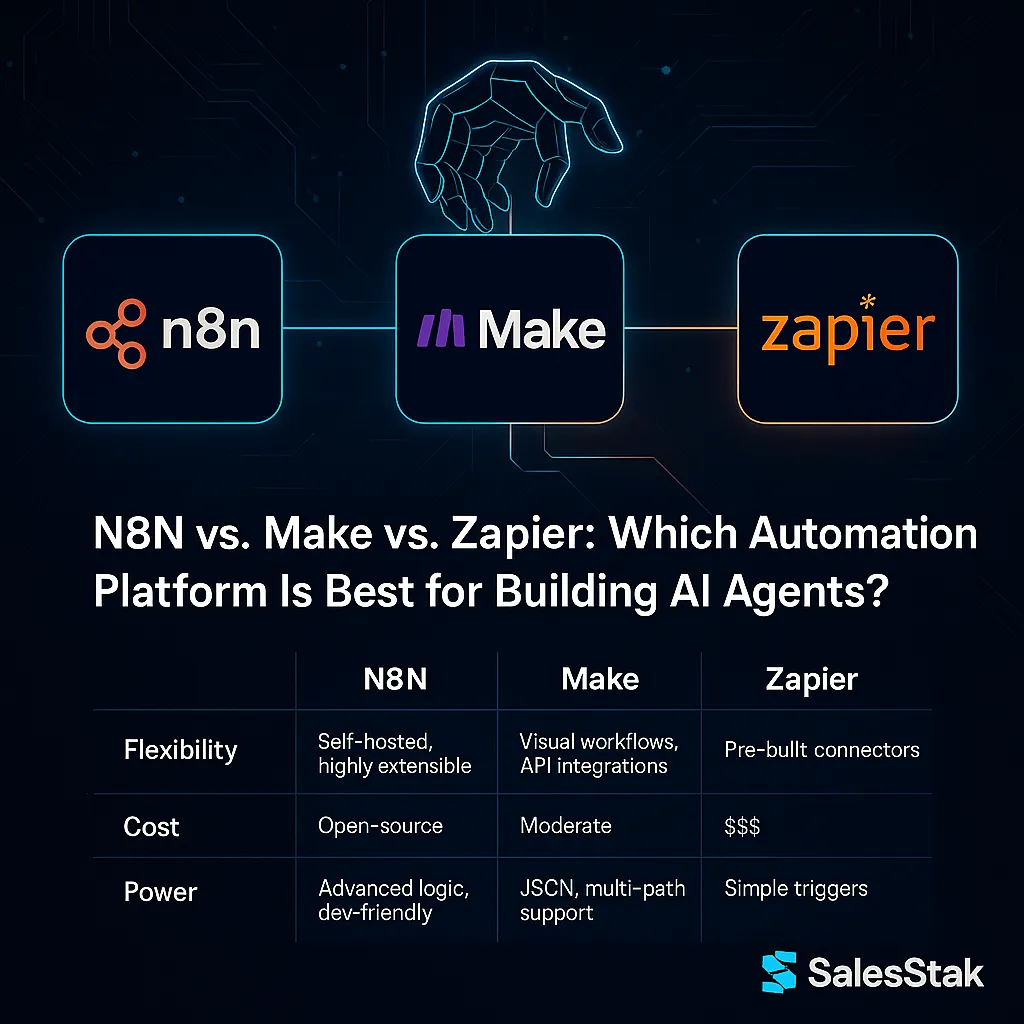
N8N vs. Make vs. Zapier: Which Automation Platform Is Best for Building AI Agents?
If you're building AI Agents for your agency or service-based business, your automation layer matters more than ever. Choosing the wrong platform can bottleneck your systems, limit flexibility, and bloat your costs.
At SalesStak, we’ve built AI Agents using all three major orchestration tools—N8N, Make (formerly Integromat), and Zapier—and this post breaks down the pros, cons, and best use cases of each.
🧠 First: What Are AI Agents Really Doing?
Before picking a platform, let’s zoom out.
AI Agents aren’t just sending a form to Slack.
They’re parsing JSON, analyzing intent, querying APIs, summarizing lead data, enriching CRM records, and triggering multi-channel workflows.
That means your stack must support:
Webhooks
Iterators and conditional logic
API authentication
Real-time processing
Scalable architecture
Modular workflows
⚖️ N8N: The Developer’s Playground (and AI Agent Powerhouse)
Best for: Self-hosted power users, technical teams, AI orchestration with advanced branching
✅ Pros:
Completely self-hosted, fully customizable
Open-source = no platform lock-in
Fine-grained control over executions, error handling, and memory usage
Modular + scalable when paired with Docker, Railway, Supabase
⚠️ Cons:
Requires technical setup and server management
Not ideal for beginners or non-dev users
We use N8N to power our SalesStak Agent Orchestrator, giving us granular control over sub-agent logic and task delegation.
⚙️ Make (Integromat): Visual Power with Flexibility
Best for: Non-dev power users who want visual control, JSON handling, and powerful branching
✅ Pros:
Beautiful visual UI (great for mapping agent workflows)
Handles JSON, arrays, iterators, routers natively
Powerful multi-path branching and scheduling
Great error-handling & built-in HTTP module
⚠️ Cons:
Slower interface for large workflows
Limited dev extensibility compared to N8N
Still SaaS-hosted, not open-source
Make is great for building client-facing automations, high-touch onboarding sequences, or nurturing AI agents with fallback logic.
🔁 Zapier: Great for Simplicity, Poor for Agents
Best for: Basic automations, quick tasks, non-technical teams
✅ Pros:
Fast to deploy, tons of prebuilt integrations
Perfect for MVPs or single-task workflows
Friendly UI, minimal setup required
⚠️ Cons:
Limited branching, looping, or AI-specific use cases
Poor JSON handling
Expensive at scale
No self-hosting
We reserve Zapier for one-off triggers, like “form submission → Slack ping” or simple CRM updates—not for anything requiring AI context.
🚀 What Platform Do We Recommend?
If you're building AI Agents with sub-agents:
➡️ Use N8N. Host it. Own it. Control the flow.
If you want powerful flows without code:
➡️ Use Make. It’s the best balance of flexibility + no-code accessibility.
If you’re just starting and need something easy:
➡️ Use Zapier, but prepare to upgrade.
🧠 SalesStak's Hybrid Approach
We use a layered stack across platforms:
N8N for orchestration & agent intelligence
Make.com for visual automation flows and client dashboards
Zapier for quick connectors or fallback workflows
The key is not choosing one tool—it’s understanding how each tool fits into your larger ecosystem.
🎯 Call to Action
Want help choosing or building your AI automation stack?
👉 Tap here to request a free Systems Mapping Session with SalesStak
We’ll show you how to map, stack, and scale your workflows using AI + the right orchestration layer.
